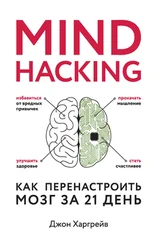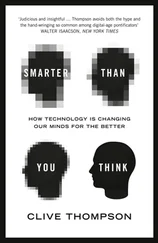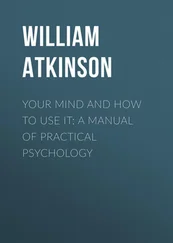After a few days, he had a chain. Now the game was to see how long he could go without breaking the chain—without missing a day of writing jokes. Each day, his satisfaction would come from seeing the unbroken chain of red Xs, that constant repetition, knowing he was steadily working toward his goal. If he missed a day, he’d have to start over, and that alone was enough to keep him working on his craft.
Again, there’s no mystery in the idea that practicing something makes you better at it—the Seinfeld system just visualizes that repetition, so you can challenge yourself to beat your previous record (“I did a two-week chain last time, let’s see if I can go for three”). The Mind Hacking app (available at www.mindhacki.ng) also lets you track “chains” of progress—though currently it does not feature a recording of Jerry Seinfeld imploring you, “DON’T BREAK THE CHAIN,” which I know would motivate me .
Repetition Method #3: Smiling in the Shower
One of the easiest ways to repeat your mental loops is to just silently recite them to yourself . This can be an efficient way of using “mental downtime” such as:
• Your daily commute
• Boring meetings
• Waiting in line
• Waiting at stoplights
• Waiting for appointments
• Exercising
• Doing chores (housework, yard work, etc.)
• While you shower (the best possible time, in my opinion)
You can accelerate this technique by repeating the positive loop to yourself, not like a zombie, but with feeling . A 2008 study by German psychologist Dr. Fritz Strack showed that smiling actually makes you feel happier. 8He had two groups of test subjects read a series of Gary Larson’s Far Side cartoons. One group was instructed to hold a pencil between their teeth without touching their lips, and one group holding the pencil between their lips but not touching their teeth. Without realizing it, the “teeth” group had their faces contorted into smiles, while the “lips” group had their faces puckered into frowns.
Amazingly, the group that was forced to smile felt happier, and found the cartoons funnier, than the group that was forced to frown. Several years later, another study showed that regular smiling will improve other areas of your life, including interacting more positively with others and thinking more optimistically. 9
By mentally repeating your positive loops to yourself while smiling, you are more likely to view them optimistically and take the positive steps needed to make the required changes in your life. You can even do one better than that by encouraging yourself to feel enthusiastic about your positive loops. Think back to when you felt truly excited or encouraged about a project or event, and try to capture that emotional state as you repeat your mental loop.
Perhaps this sounds like I am encouraging you to become a grinning lunatic, rocking back and forth as you repeat things to yourself on the highway. The difference between the mental repetition technique and OCD is that you are reprogramming the mind, not repeating things out of compulsion or anxiety. You will see the difference, because it is difficult to do! It is much easier to turn on a podcast or check your email (our true obsessive-compulsive disorders) rather than taking a few moments to calmly repeat your mental loops.
Think of this technique as “Smiling in the Shower” and it really works. “It took years for your mind to build its scaffolding of tricks and worries,” says Dr. Joan Borysenko, the Harvard-trained psychologist. “It will take time to dismantle them.” 10And the key to that dismantling is repetition.
Repetition is . . . well, you know.
MIND GAME
Reminding Your Mind
Set up a reminder system for yourself, similar to the ideas in Section 3.2, that will repeatedly bring one of your positive loops to mind:
• Repetition Reminders: The $10 Million Check
• Repetition Trackers: Don’t Break the Chain
• Talking to Yourself: Smiling in the Shower
Write down a brief description of your reminder system on your practice sheet.
[3.3]
Nikola Tesla may have been the greatest geek who ever lived.
The Serbian-American inventor was awarded three hundred patents during his lifetime, beginning with electric motors, and eventually encompassing such diverse inventions as ship navigation devices, wireless lighting, and a plane that would take off and land vertically—all in the early 1900s. 1In harnessing the forces of nature, Tesla seemed almost godlike in his powers: at one of his labs, he generated 135-foot bolts of artificial lightning, creating thunder that could be heard 15 miles away. 2
Like many great thinkers, some of Tesla’s ideas seemed insane for the time, even by today’s standards. He had plans for a robot that could operate of its own free will and free countries from war; 3the saturation of schoolrooms with electric fields to enhance the intelligence of children; 4and a “death ray” that he boasted could bring down ten thousand enemy airplanes at a distance of two hundred miles. 5Because he was a terrific showman, he earned a popular reputation as a “mad scientist,” and it was sometimes difficult to know what he had actually invented, what was in development, and what existed only in his mind.
For many years, Tesla tried to perfect a device that could project your thoughts onto the wall , an invention he called the “thought camera.” As he explained in a newspaper interview late in his life, “In 1893, while engaged in certain investigations, I became convinced that a definite image formed in thought, must . . . produce a corresponding image on the retina, which might be read by a suitable apparatus.” 6His diagram of this device resembled a movie projector, with the operator staring into the machine, which projected his thoughts on the wall. Being able to project your thoughts like a movie, you have to admit, would be both incredibly cool and incredibly disturbing.
The thought camera was a natural fit for Tesla, who from an early age showed an unusual ability to see pictures in his mind. In fact, he was afflicted with a particularly severe form of what today would be called “visual thinking” or “picture thinking.” A simple word like “engine” would trigger a vision of the object—a vision so strong that, as he later explained, “Many times it was impossible for me to tell whether the object I saw was real or not.” 7He literally could not tell the difference between his mental pictures and the real world, a handicap that caused him considerable anxiety and discomfort throughout his life.
But this strange curse could also be a blessing: as a child, he was able to do integral calculus in his head, leading his teachers to think he was cheating. 8As he grew older, he began to gain mastery over the mental pictures, learning to visualize his inventions in great detail before writing down a single word.
His style was a marked contrast with that of Thomas Edison, who was also his boss—and later his archnemesis. Tesla rose to prominence working under Edison, and perhaps it was inevitable that the two great men, with their differing approaches, would eventually become bitter enemies. The animosity began when Edison asked Tesla to redesign his direct current generators; Edison allegedly claimed he would pay Tesla $50,000 for completing the project. When Tesla delivered the goods, the notoriously stingy Edison claimed the offer had been a joke—but as a consolation prize, he would raise Tesla’s salary from $10 to $28 per week. Tesla told Edison he could take his generator and shove it.
Tesla went on to develop the alternating current (AC) standard of electricity, which was in direct competition to Edison’s direct current (DC) standard. The two men waged a bitter war of public relations and reputations, officially known as the “War of Currents,” with Tesla’s AC standard eventually winning out. Some biographers believe they both refused a joint Nobel Prize because neither man wanted to share it with the other.
Читать дальше
![Джон Харгрейв Mind Hacking [How to Change Your Mind for Good in 21 Days] обложка книги](/books/404192/dzhon-hargrejv-mind-hacking-how-to-change-your-min-cover.webp)











